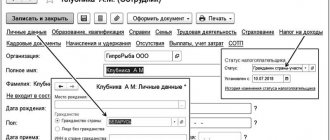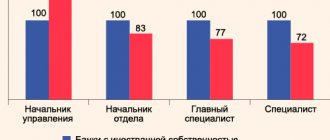An individual entrepreneur who needs funds for personal needs can take money from the cash register or transfer it from the individual entrepreneur’s account to his personal account. The owner of a legal entity does not have the right to perform such actions. You can legally satisfy your need for money by drawing up an interest-free loan agreement from your own enterprise. Current legislation does not prohibit this. It is important to know what tax consequences may accompany loan forgiveness to the founder.
The procedure for registering the issuance of borrowed funds to the founder
The Civil Code of the Russian Federation allows for issuing and receiving loans. One party to the transaction may be the founder, and the other – his own company. Moreover, both parties can act as both a lender and a borrower.
In a transaction where the founder acts as the borrower, it is important to comply with all legal rules:
- If a company is created by a group of people, it is necessary to obtain consent to issue borrowed funds from all founders. For this purpose, a council is assembled, the decision of which is documented in a special protocol. The document states the consent of the co-founders to issue a loan.
- The essential points of the agreement are preliminarily discussed: amount, terms, absence (presence) of interest for the use of borrowed funds, debt repayment schedule.
- A written agreement must be drawn up and signed by the borrower and the lender. In a situation where the borrower and lender are the same person, the agreement must be endorsed by an independent representative of the company. A chief accountant or financial director would be suitable for this role.
- After completing the documents, the founder receives money through the company's cash desk or by transfer to his current account.
Accounting, postings
Because the forgiven debt should not be taken into account when calculating the taxable base, permanent differences with permanent tax liabilities may arise in accounting. Such discrepancies must be shown according to D99 and K68 . When forgiving a debt or part of it, enterprises can use the following standard correspondence:
- D62 – K90.1 – the fact of sale of commercial products was recorded.
- D90.3 – K68 – VAT has been charged.
- D90.2 - K41 - reflects the write-off of the actually generated cost of the shipped batch of goods.
- D51 – K62 – the debtor transferred part of the debt amount to the supplier’s account.
- D91.2 – K62 – partial or full repayment of debt as a result of signing a debt forgiveness agreement.
- D99 – K68 – based on the calculation certificate, a permanent tax liability is shown.
If accounts payable were formed not for the supply of goods, but as a result of the provision of borrowed funds, then the loan itself and the interest on it must be taken into account separately. When drawing up an agreement on debt forgiveness, it is recommended to clarify exactly what amounts the agreement applies to: only borrowed funds or interest accrued on them, including. Legal entities can draw up an agreement to cancel not the debt itself, but interest or penalties on it.
When interest is forgiven for the use of borrowed resources, an entry D91.2 - K76 for the amount of interest written off. There are no VAT consequences for both parties, since cash loans are not subject to this type of tax. The forgiven debt in the amount of interest payments is not an expense transaction (Letter of the Ministry of Finance dated December 31, 2008 No. 03-03-06/1/728). But in accounting according to PBU 18/02, this operation entails costs. Loan interest forgiveness correspondence:
- D58.3 – K51 – borrowed funds issued;
- D76 – K91.1 – posting monthly interest accrual on the debt amount;
- D51 – K58.3 – repayment of the principal debt;
- D91.2 – K76 – interest charges specified in the debt forgiveness agreement are cancelled;
- D99 - K68 - a permanent tax liability is recorded in accounting.
Debt write-off
A loan issued to the founder can be written off if it is repaid by the borrower or after the debt is forgiven. If the return of money is a standard procedure, then writing off (forgiveness) the debt has its own nuances of registration and tax consequences for both the borrower and the lender.
The return of the amount of money by the borrower of the company is reflected in the accounting by the following entries: Dt 50 (51) Kt 66, (67) - cash return to the cash desk (through the bank) of a short-term (long-term) loan.
When might debt forgiveness be the only option?
Debt forgiveness between legal entities (despite weak legislative regulation) cannot be called a rare transaction. There are situations in business when such a gesture may be the only possible one. And in addition to the most obvious situations related to the liquidation of a legal entity or the recognition of its insolvency, some others should be mentioned: the end of the service life of the property, the high cost of transportation, the high cost of installation and other operational features that lead to the loss of interest of the creditor in the property.
This is the main feature of forgiveness, which distinguishes this procedure from donation. By initiating the procedure for debt forgiveness (in whole or in part) of the debtor, the creditor must receive a certain, preferably material, benefit, and prove its existence in court. The disputes with the tax authorities, which we mentioned above, usually revolve around this question: was there a fact of benefit?
In order to avoid the unpleasant consequences of lawsuits in the future, you should take care in advance about the availability of such benefits. If the subject of the debt obligations was a certain mechanism, the creditor can prove that it is already out of order, “its repair would be too expensive, and then there’s transportation and installation!
As you can see, the Russian tax code contains an article providing for debt forgiveness. The main thing in this case is to prove that we are not talking about a desire to hide part of the income by including them in expenses, but about a rational decision to terminate relations with the debtor. The transaction can be executed either unilaterally or after agreement between the debtor and the creditor. It is concluded in the standard mode, the form is not prescribed in the Civil Code. If the tax authorities have claims against the transaction, the creditor will have to make efforts to prove that the forgiveness was not a gift. Let us remind you that donations to legal entities are prohibited at the legislative level.
Forgiveness of debt to the founder
Legislative norms allow debt forgiveness to any borrower, including the founder. The procedure for this procedure is regulated by Art. 405, and 417 of the Civil Code of the Russian Federation.
Such a transaction is sealed with a notice or agreement (agreement) on debt forgiveness. The documents must indicate on what basis the loan was received and what amount is forgiven to the borrower.
To write off a debt, you must have compelling reasons, supported by documents:
- deterioration in the health of the founder or members of his family;
- deterioration of financial situation;
- loss of a breadwinner;
- complete or partial destruction of housing due to natural disasters;
- other compelling reasons.
Once the debt forgiveness agreement has been drawn up, the borrower has no objections and signs it, the transaction must be reflected in the company's accounting and reporting.
How to apply for debt forgiveness between legal entities
Provisions of Art. 415 of the Civil Code of the Russian Federation gives the creditor the authority to forgive and write off debts in relation to debtors from among legal entities. The criterion for the legality of a transaction is the absence of facts of violation of the debtor’s rights. If the other party has objections to the forgiveness of debt amounts, it must notify the creditor of this.
Question: How to take into account income in the form of the amount of forgiven debt and interest under a loan agreement for income tax purposes? View answer
The date of debt forgiveness is the day the debtor receives from his creditor a written notification of the amnesty of specific obligations. Another option for documenting the transaction is drawing up a bilateral debt termination agreement. The agreement must include the following information:
- the amount of accumulated debt that is expected to be forgiven;
- details of the contractual documentation, in accordance with which financial obligations of a credit nature appeared on one party;
- primary documents confirming the occurrence of the debt;
- circumstances and conditions under which the debt will be considered written off.
NOTE! The agreement must be supported by all documents mentioned in its text (copies of agreements, initial forms).
For an agreement to have legal force, it must contain information about the creditor and debtor (names, details), the subject of the transaction, the amount to be repaid, the absence of objections from the parties, and the economic justification for the need for such a step. The last requirement is recommended to be taken into account in order to prevent the possibility of treating the transaction as a donation transaction.
How to reflect in the debtor's accounting the forgiveness of the debt to pay for purchased goods (works, services)?
An economic justification may include obtaining material benefits from debt forgiveness:
- the debtor undertakes to provide a discount on subsequent deliveries;
- the emergence of the possibility of concluding new promising cooperation agreements between the parties.
An agreement to forgive all or part of the debt may be part of a debt restructuring program developed by enterprises. This compromise option avoids transferring the debt to the bad category.
BY THE WAY , to minimize the risk of disputes with regulatory authorities, the forgiveness agreement recommends not writing off the entire amount of the existing debt, but only part of it.
In the text of the agreement, you can indicate that the transaction is not an act of donation; the debtor undertakes to repay the remaining part of the debt within a certain time frame. If there is evidence that debt collection will cause material losses for the creditor, they must be stated in the text of the agreement.
IMPORTANT! In an agreement on debt forgiveness, all wording must be extremely precise and clear in order to prevent the possibility of their interpretation in favor of the version of donation of assets, which is prohibited between legal entities under Art. 575 of the Civil Code of the Russian Federation.
An additional condition for recognizing a transaction as valid is the presence of a current reconciliation report between interested parties confirming the amount of debt. Algorithm of actions of the lender:
- drawing up a reconciliation report with the debtor;
- sending a notice to the debtor of the intention to forgive him all or part of the debt;
- waiting for objections from the other party;
- If there are no contradictions between the parties to the transaction, the procedure is documented: a forgiveness agreement or an additional agreement to the current supply or service agreement is drawn up.
Tax consequences of loan forgiveness to the founder for the lender
The amount forgiven to the debtor is reflected in the accounting records as part of other expenses in the debit of account 91 “Other income and expenses.” The basis document for the accounting entry is the agreement (notice) on debt forgiveness. An interest-free loan is included in accounts receivable; the forgiveness procedure repays the amount and reduces the capital of the enterprise.
Important! When calculating income tax, funds transferred under loan agreements are not included in expenses. When a loan is forgiven, written off receivables are not recognized as an expense (Clause 16, Article 270 of the Tax Code of the Russian Federation).
This creates a permanent difference and a corresponding permanent tax liability. The accounting entry will reflect the PNO as follows: Dt 99 Kt 68 (income tax).
Question and answer: Taxation of the debtor and creditor using the simplified tax system
Question:
LLC (USNO 6%) issues an interest-bearing loan to individual entrepreneurs (USNO 6%).
The statute of limitations for loan repayment expires in 2021. LLC and individual entrepreneur decided to write off the loan as receivables (LLC) and accounts payable (IP). The loan amount and interest will be written off in full.
What will taxation look like for the debtor and the creditor?
Answer:
From the debtor:
Source: {Question: About accounting for income tax purposes for the amount of the loan and interest on it forgiven by the shareholder. (Letter of the Ministry of Finance of Russia dated March 18, 2016 N 03-03-06/1/15079) {ConsultantPlus}}
As for debt in the form of interest on a loan, written off by forgiving the debt, then, on the basis of paragraph 18 of Article 250 of the Code, these amounts are subject to inclusion in the non-operating income of the debtor organization.
Source: {Question: About accounting for income tax purposes for the amount of the loan and interest on it forgiven by the shareholder. (Letter of the Ministry of Finance of Russia dated March 18, 2016 N 03-03-06/1/15079) {ConsultantPlus}}
According to official explanations, in the general case , funds previously received under a loan agreement and remaining at the disposal of the organization as a result of forgiveness of its debt are considered as received free of charge. Such funds (the principal amount of the loan) are recognized as non-operating income on the basis of clause 2 of Art. 248, paragraph 8, part 2, art. 250 Tax Code of the Russian Federation. This point of view is confirmed, in particular, by Letter of the Ministry of Finance of Russia dated December 14, 2015 N 03-03-07/72930.
As for the forgiven interest under the loan agreement, the Russian Ministry of Finance and the tax authorities expressed the opinion that these amounts cannot be considered as property received free of charge, since there is no fact of transfer of these funds to the taxpayer. Such amounts are included in non-operating income on the basis of clause 18, part 2, art. 250 of the Tax Code of the Russian Federation (as the amount of written off accounts payable) (see, for example, Letters of the Ministry of Finance of Russia dated 03/18/2016 N 03-03-06/1/15079, Federal Tax Service of Russia dated 05/02/2012 N ED-3-3/ [email protected ] ).
The specified income is recognized in the reporting period in which the notification from the lender about debt forgiveness is received (clause 1 of Article 271 of the Tax Code of the Russian Federation).
From the lender:
Source: Deal Guide Debt forgiveness. Lender {ConsultantPlus}
The amount of the principal debt under the loan agreement is not included in the income of the lender (lender), regardless of whether the borrower returned this amount or the debt was forgiven upon its return. In this case, the method of recognizing income and expenses in tax accounting does not matter (clause 10, clause 1, article 251 of the Tax Code of the Russian Federation).
As for interest under a loan agreement, when applying the accrual method, they are recognized as part of non-operating income at the end of each month of using the loan, as well as on the date of termination of the loan agreement. In this case, the fact of payment does not matter (clause 6 of Article 250, paragraph 3 of clause 4 of Article 328, clause 6 of Article 271 of the Tax Code of the Russian Federation). Consequently, in the month of debt forgiveness to the borrower, the lender must recognize non-operating income in the amount of interest accrued under the loan agreement for the period from the 1st day of this month to the date of debt forgiveness (inclusive).
Regarding the accounting for profit tax purposes of the amount of forgiven debt, even in the case where the debt is partially forgiven in order to receive from the debtor the remaining amount of debt under the agreement, we note the following.
Based on the position of the Presidium of the Supreme Arbitration Court of the Russian Federation, given in Resolution No. 2833/10 of July 15, 2010 in case No. A82-7247/2008-99, the creditor has the right to recognize part of the debt forgiven to the debtor in order to receive from him the remaining amount of debt under the agreement, as part of non-operating expenses for profit tax purposes. This approach is due to the fact that debt forgiveness is aimed at generating income, but in a smaller amount. Despite the fact that the specified position of the Presidium of the Supreme Arbitration Court of the Russian Federation was formed in relation to the situation related to debt forgiveness under a supply agreement, in our opinion, this position is also applicable when debt is forgiven under a loan agreement.
However, according to the Russian Ministry of Finance, the amount of the forgiven debt, even in the case when the debt is forgiven partially in order to receive from the debtor the remaining amount of the debt under the agreement, is not taken into account as part of non-operating expenses for profit tax purposes. This position of the financial department is based on the fact that the amount of written off receivables is not a justified expense in accordance with Art. 252 of the Tax Code of the Russian Federation and forgiveness of part of the debt is not aimed at generating income. This conclusion follows, for example, from Letter of the Ministry of Finance of Russia dated 04/04/2012 N 03-03-06/2/34. Although this Letter concerns the situation related to the forgiveness of debt under a loan agreement, in our opinion, the conclusion made in it is applicable in the case under consideration. For existing points of view on this issue, see the Encyclopedia of Controversial Situations on Income Tax.
At the same time, we note that according to the clarifications of the Ministry of Finance of Russia (Letters dated 04.06.2015 N 03-04-05/32513, dated 07.11.2013 N 03-01-13/01/47571 (sent to the Federal Tax Service of Russia for information and use in the work of lower tax authorities authorities by Letter dated November 26, 2013 N GD-4-3/21097)) in a situation where the explanations of the financial department are not consistent with the decisions, resolutions, information letters of the Supreme Arbitration Court of the Russian Federation, as well as decisions, resolutions, letters of the Supreme Court of the Russian Federation, tax authorities in their work must be guided by the specified acts and letters of the courts from the day of their official publication in the prescribed manner or from the date of their publication in full on official websites on the Internet.
Thus, in the presence of the Resolution of the Presidium of the Supreme Arbitration Court of the Russian Federation dated July 15, 2010 N 2833/10, it can be assumed that the likelihood of disputes arising on the issue under consideration will decrease.
Simplified tax system and accounting with the lender when forgiving a debt under a loan agreement
When a debt is forgiven, the obligation of the debtor-borrower to the creditor-lender ends (Clause 1 of Article 415 of the Civil Code of the Russian Federation). An obligation as a result of debt forgiveness is considered terminated from the moment the debtor receives the creditor's notification of debt forgiveness, unless the debtor within a reasonable time sends an objection to the debt forgiveness to the creditor (Clause 2 of Article 415 of the Civil Code of the Russian Federation).
simplified tax system for debt forgiveness under a loan agreement
The amount of the principal debt on the loan is not included in the income of the creditor (lender), regardless of whether the borrower returned this amount or the debt for its repayment was forgiven (clause 1, clause 1.1, article 346.15, clause 10, clause 1, article 251 of the Tax Code of the Russian Federation ).
Regarding interest under a loan agreement when debt is forgiven, we note the following.
Income under the simplified tax system is recognized on the date of receipt of funds into bank accounts and (or) cash desks, receipt of other property (work, services) and (or) property rights, as well as repayment of debt to the taxpayer in another way (clause 1 of Article 346.17 of the Tax Code RF).
When a debt is forgiven, the amount of interest not paid by the borrower is not subject to payment to the lender. Such unpaid interest from the lender is not taken into account as part of income when determining the tax base under the simplified tax system. This conclusion follows from an analysis of the explanations given in Letter of the Ministry of Finance of Russia dated May 31, 2016 N 03-11-06/2/31354.
The review was prepared by specialists from the Consulting Institute of the Group of Companies "Zemlya-SERVICE"
Tax consequences of loan forgiveness for the borrower
When a debt is forgiven, the borrower-founder generates income that must be subject to personal income tax at a rate of 13%. Date of income – the date the debt is written off from the organization’s balance sheet.
Important! The payroll accountant should withhold from the founder 13% personal income tax on the amount of the forgiven debt and personal income tax on other income. The total amount of deductions should not exceed 50% of the income received.
If a tax agent cannot withhold personal income tax, he is obliged to notify the tax office and the taxpayer. To do this, a form in form 2-NDFL is submitted to the Federal Tax Service with the number 2 entered in the “Sign” field.
Insurance premiums are not charged on the amount of the forgiven debt, since the loan agreement is a section of civil law relations. The funds received from the loan become the property of the founder, and such transactions are not subject to insurance premiums.
Tax consequences and taxation
After both parties sign an agreement canceling the debt, entries are made in the creditor’s accounting to write off the debt as expenses. In tax accounting, you need to focus on the applicable tax regime.
If the lender uses the accrual method, then revenue is recognized without reference to the date of actual receipt of income. When a debt is forgiven, a situation arises when revenue for tax purposes has already been reflected in accounting, the goods have been shipped, and the debt for them is canceled. Revenue in this case is not subject to adjustment. If the lender practices the cash method, then the date of receipt of income and its recognition in accounting coincide. Therefore, adjustments are allowed.
When concluding a debt cancellation agreement between legal entities, the amount of debt repaid in this way should not be considered overdue. There are several options for writing it off:
- repayment from net profit funds;
- write-off for non-operating expenses in order to reduce the tax base.
The first method is based on the position of the Ministry of Finance and tax authorities that such debt write-off does not have signs of economic justification for recognition as an expense in the tax base for income tax. Regulatory authorities equate the transaction to a gratuitous transfer operation. In relation to VAT, debt forgiveness has no effect. When canceling a debt, the debtor records non-operating income.
There is no need to impose income tax on income received from founders or commercial organizations that have a share in the authorized capital of the debtor (from 50%). The norm is enshrined in Art. 251 Tax Code of the Russian Federation. In relation to property, there is a rule according to which, when a debt is forgiven, there is no transfer of property assets; the debtor receives only property rights. To prove the opposite, it is necessary to obtain a positive decision from a judicial authority.
The tax authorities insist that when a debt is forgiven, the debtor enterprise does not actually incur any expenses. Justification – Determination of the Constitutional Court of the Russian Federation dated November 4, 2004. The creditor’s economic losses from the debt cancellation transaction are due to the inability to adjust downward his tax obligations on amounts for which payment has not been received.
Formation of tax and accounting reports
Yes, the Landlord Organization can forgive part of the debt to the Tenant due to a difficult financial situation.
He also has the status of an individual entrepreneur and applies the simplified taxation system with the object of taxation “income minus expenses.” An individual lent money at interest to companies in which he is a participant. Loans were issued both during the period when the citizen was a member of the companies, and during the period when he was not yet a member of the companies.
Taxpayers using the simplified system determine income from the sale of goods, works, services and property rights in the manner established by Art. 249 of the Tax Code of the Russian Federation, and non-operating income - in the manner established by Art. 250 Tax Code of the Russian Federation. 1 tbsp. 346.15 Tax Code of the Russian Federation.
Individual entrepreneur “husband” - simplified tax system (6%), individual entrepreneur “wife” - simplified tax system (6%). Individual entrepreneur “husband”, at the expense of income from his business activities, on which he has paid tax, issues an interest-bearing loan to individual entrepreneur “wife” for the development of entrepreneurial activity. There are no payments under the loan agreement. After a year, the individual entrepreneur “husband” forgives the debt of the individual entrepreneur “wife”.
And income in the form of interest on the loan is taken into account on the date of forgiveness, since on this date the debtor’s debt to pay interest ceases. The amount of the forgiven debt is not recognized as part of the expenses taken into account when determining the tax base under the simplified procedure.
Thus, debt forgiveness is a unilateral legal action, that is, it does not require the conclusion of any agreement between the parties. It can be issued in the form of a decision of the authorized body of the creditor, a notice, or any other unilateral document (for example, a message).
The income in question should be taken into account for the purpose of calculating tax when applying the simplified tax system on the date of debt forgiveness.
A blog is your new tool to talk about yourself. Publish any content about your company.
Forgiveness of a debt from an individual entrepreneur should be considered as revenue from the sale of services. The income in question should be taken into account for the purpose of calculating tax when applying the simplified tax system on the date of debt forgiveness.
Can a legal entity enter into voluntary liquidation without distribution of net profits or forgiveness of debt? How high is the risk of a tax audit after filing an application for voluntary liquidation?
Debt forgiveness by organization
Before executing a debt forgiveness transaction, the creditor must notify the debtor of his offer in writing. If he sends a letter of objection, debt forgiveness cannot be carried out. If the debtor does not take any actions that could be regarded as objections, or agrees to the transaction, the paperwork can begin.
Where to get a loan Loan amount, rub. Repayment terms Methods of receiving MigCredit 3000-30000 7-35 days Money transfer systems, Bank account, Transfer to the “Corn” card in Euroset stores Vivus 500-15000 14-30 days To a bank account, to a QIWI wallet. in cash through the CONTACT system or to a VISA or MasterCard bank card ELoan 2000-20000 14-30 days To a bank account, to a QIWI wallet. in cash through the CONTACT system or to a bank card VISA or MasterCard Payment 1000-15000 5-45 days Visa, MasterCard, Contact, Yandex money, Qiwi MoneyMen 1500-15000 5-31 days To card, account, cash, Yandex money Standard rules may be changed on an individual basis. For example, when issuing money on bail.
This opportunity is used quite rarely in business practice, since the nature of the transaction raises many questions related to the legality of actions and documentation. The Tenant organization is in a difficult financial situation. Has a large debt (2,000,000 rubles) to the Lessor. The tenant requested forgiveness of part of the debt in the amount of 200,000 rubles in 2015. and parts in the amount of 300,000 rubles in 2021. The Tenant and the Lessor are on the Simplified Taxation System, income reduced by the amount of expenses. Question. Does the Lessor organization have the right to forgive part of the debt under the current Agreement?
So what is debt forgiveness and how realistic is it to document such a situation in compliance with established legislation?
However, it is possible that inspectors think differently. The fact is that in this situation, VAT will not be transferred to the seller and the buyer will not incur real costs for the purchase of goods, works, and services.
Creditors may be interested in the possibility of collecting debts from the assets of the business, including from the proceeds of a loan that was supposed to be forgiven.
The date of receipt of such income will depend on the person to whom the loan is forgiven. If the employee is interdependent, then the date of receipt of income is the day the debt is written off from the balance sheet of the creditor organization.





